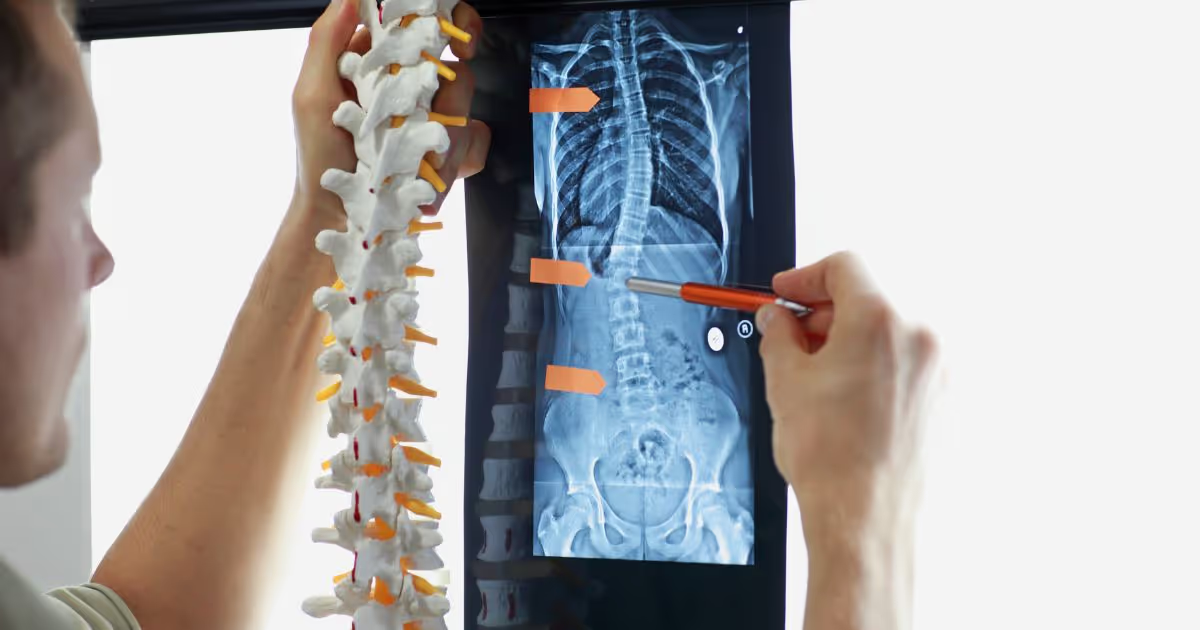Scoliosis
Scoliosis is a condition where the spine curves and deviates sideways. Noticeable physical findings are as follows:
- Uneven shoulders or hips.
- Asymmetric rib cages with unequal height.
- A shoulder blade on one side of the chest is more convex than the other.
- Sideway deviation of torso or hip, causing misaligned head and pelvis.
Scoliosis affects 3% of the population. Often diagnosed during childhood or adolescence, it occurs equally in both genders, but females have an eight-fold higher risk of scoliosis progression that requires surgical treatment.
In general, scoliosis does not cause symptoms aside from poor body image. Those with marked spinal deformities can have a tilted torso with back pain. In severe cases, scoliosis can squash the chest cavities, reducing the space for the growing heart and lungs and compromising cardiopulmonary fitness and their physiologic functions, which can be life-threatening.
Causes of scoliosis
There are three etiologic types of scoliosis:
- Idiopathic scoliosis is the most common, constituting 80% of cases. It is related to genetics and usually begins early in adolescence. The deformity increases with physical growth.
- Congenital scoliosis is due to the embryonic malformation of one or more vertebrae at any spine location. Uneven growth of the spinal column causes curvature and other spine deformities.
- Neuromuscular scoliosis is due to cerebral palsy, spinal cord trauma, and muscular dystrophy. This type of scoliosis progresses more rapidly and often requires surgery.
การตรวจร่างกายเบื้องต้นเองที่บ้าน
Perform self-assessment by standing with both feet close together and bending forward 90 degrees at the waist. If you have scoliosis, trunk asymmetry, and abnormal spinal curvature will be detectable.
Imaging tests provide more diagnostic details.
- A spinal X-ray is the standard diagnostic imaging to measure the degree of spinal deviation and assess spinal flexibility with a side-bending view.
- CT scan helps identify the severity of spinal deviation and planning of surgical treatment.
- MRI can diagnose spinal and nerve abnormalities which may accompany scoliosis.
การพิจารณาทางเลือกในการรักษา มีปัจจัยที่เกี่ยวข้อง
To select the appropriate treatment, your doctor will consider the following factors.
- Age: Scoliosis is related to the maturity of the spine. Younger children with spinal curvature have a higher risk of increased spinal deviation over time.
- Location of the curvature: the thoracic spine is more likely to deviate than other spinal regions.
- The severity of curvature: The higher the degree of curvature, the greater the chance for surgery.
- Gender: Women are more likely to develop more severe scoliosis than men.
Treatments
Treatments include observation, bracing, and surgery, depending on the severity and age of the child.
Observation
It is for patients with mild scoliosis (less than 20-25 degrees) or those with idiopathic adolescent scoliosis with a low risk of increased deviation. Your doctor may recommend observing the symptoms and having a follow-up appointment every 4-6 months until the spinal growth maturity.
People with scoliosis can do daily activities as usual. Some research concludes that people with scoliosis who exercise regularly have a lower risk of increased deviation than those who do not.
Bracing
Bracing is suitable for young patients who are still growing and not yet reached spinal maturity (girls and boys less than 14 and 16 years old, respectively) and have mild spinal deviation (25-40 degrees). Bracing cannot prevent increased curvature but can delay its progression. It is manufactured from moldable plastic to fit the patient's anatomy and is wearable under loose-fitting clothing. Patients can resume their daily activities as usual. However, wearing the brace for 16-23 hours a day is necessary for a successful outcome; patient cooperation plays an important role here. Back braces are rarely appropriate in older adults except when they can help relieve pain.
Scoliosis Surgery
For patients with a spinal deviation of more than 40 degrees or rapid curvature progression, surgery is advisable to correct the misalignment and prevent the progression. There are several surgical techniques, depending on the type of scoliosis.
- Spinal surgery with rigid metal rods to correct the deformity, followed by posterior spinal fusion, is the most common surgical treatment for teenagers and young adults who have stopped growing. After surgery, your child may still need to wear a brace for back protection while it heals.
- Anterior Scoliosis Correction (ASC) to fuse the spine from the front.
- The MAGEC™ (Magnetic Expansion Control) Spinal Growing Rod, designed for young children, can be expanded with an external remote control that activates the magnet in the rods to lengthen the rod to keep up with their growth and minimize the degree of curvature while waiting for spinal growth maturity and revision surgery.
Scoliosis often appears in early adolescence, a time of rapid bodily growth and hormonal changes. Patients must deal with physical and psychosocial changes. The deformity can impact their emotional state, causing anger, insecurity, fear of movement, and social avoidance. Their family should encourage and support patients to continue daily activities as usual. For adolescents with severe scoliosis, seeing a psychiatrist or being in a support group can be beneficial.













